Table of Contents
- Introduction
- Editor’s Choice
- Global Adoption – Virtual Assistant Statistics
- Global Virtual Digital Assistant (VDA) Market Size
- Industries Utilizing Virtual Assistants Statistics
- Consumer Adoption and Preferences
- Adoption of Virtual Assistant in Home Statistics
- Virtual Assistance Statistics by Gender
- Virtual Assistance Statistics by Age
- Virtual Assistance Statistics by Academic Qualification
- Virtual Assistant Statistics by Major Key Players
- Virtual Assistant Statistics by Employment
- Recent Developments
- Conclusion
- FAQs
Introduction
Virtual Assistant Statistics: A virtual assistant (VA) is an AI-powered software application designed to simulate human interaction and assist users in completing tasks, answering questions, and providing information or services.
They leverage technologies such as natural language processing (NLP), speech recognition, and machine learning to understand and respond to user inputs, whether typed or spoken.
Virtual assistants continue to evolve, becoming more sophisticated and integrated into various aspects of our lives. Their convenience and functionality make them a prominent part of the modern technology landscape.
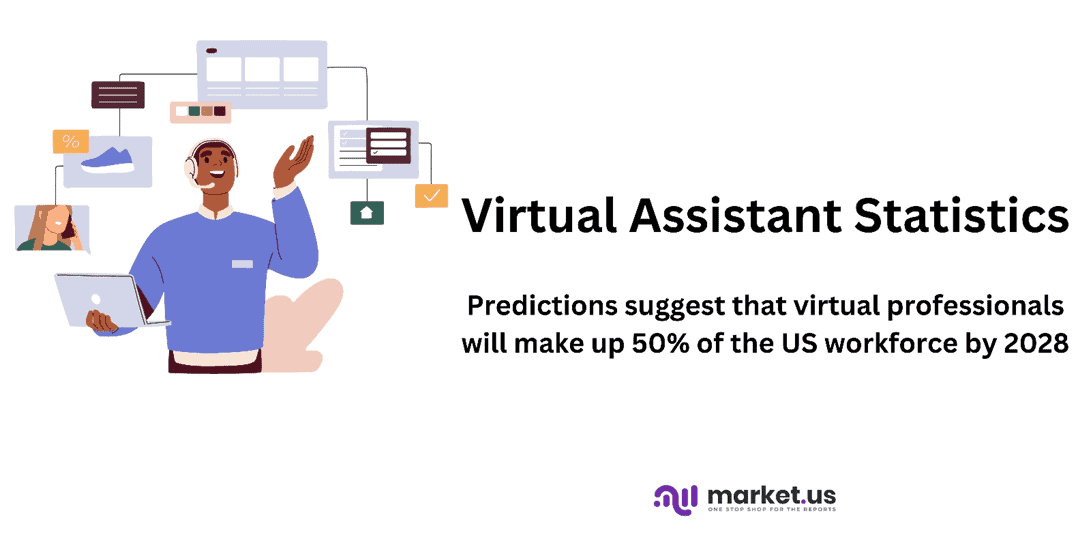
Editor’s Choice
- The Global Intelligent Virtual Assistant Market is projected to have a moderate-paced CAGR of 35.1% during the forecast period. The current valuation of the intelligent virtual assistant industry is USD 15.3 Billion in 2023 and reach a high of USD 309.9 Billion by the year 2033.
- By employing a virtual assistant, businesses can achieve a cost reduction of 78%.
- Predictions suggest that virtual professionals will make up 50% of the US workforce by 2028.
- Among individuals aged 18 to 29, 28% actively employ virtual assistants, showcasing their prevalence among younger demographics.
- Virtual assistants earn between $2 and $20 per hour.
- Hourly wages are the compensation method for 87% of virtual assistants.
- The expense of virtual assistants is 78% lower than that of full-time, in-person employees.
- In the United States, the typical age of a virtual assistant is 40.
- A virtual assistant is utilized by 35% of well-paid executives.
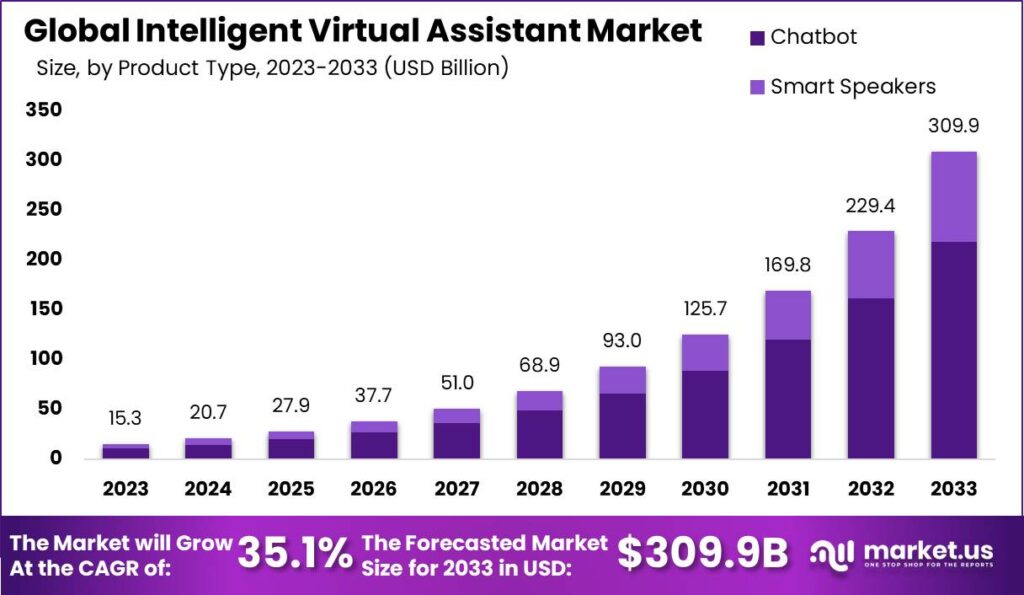
Global Adoption – Virtual Assistant Statistics
- Once confined to the realm of science fiction, virtual assistants have seamlessly integrated into billions of devices across the globe. The year 2026 is expected to witness a staggering presence of over 150 million voice assistants in the United States.
- Although initially introduced through smartphones, the widespread adoption has been predominantly attributed to smart speakers. The emergence of Amazon Echo in 2014 marked a turning point, embedding smart speakers into domestic settings.
- A notable example is that, as of 2022, around thirty percent of households in the United States and the United Kingdom engaged with smart speakers daily.
- Anticipating an expansive trajectory, the global installed base will surpass 27 billion units by 2028. This ongoing surge in popularity is set to further establish smart speakers as household staples, thus propelling virtual assistants into an increasing number of homes.
(Source: Statista)
Global Virtual Digital Assistant (VDA) Market Size
- The revenue generated by virtual digital assistants has experienced a remarkable growth trajectory over the years. In 2015, the revenue stood at $1,640 million; by 2016, it witnessed a moderate increase to $1,939.40 million.
- The subsequent years marked a significant acceleration in revenue generation, with 2017 reaching $3,001 million and 2018 soaring to $5,216.50 million.
- The upward trend continued in 2019, as revenue climbed to $8,559.70 million, showcasing substantial growth.
- The year 2020 saw a further surge, with revenue reaching $12,120.90 million, while 2021 witnessed a notable increase to $15,792.60 million. This consistent escalation in revenue underscores the growing prominence and widespread adoption of virtual digital assistants across various sectors.
(Source: Statista)
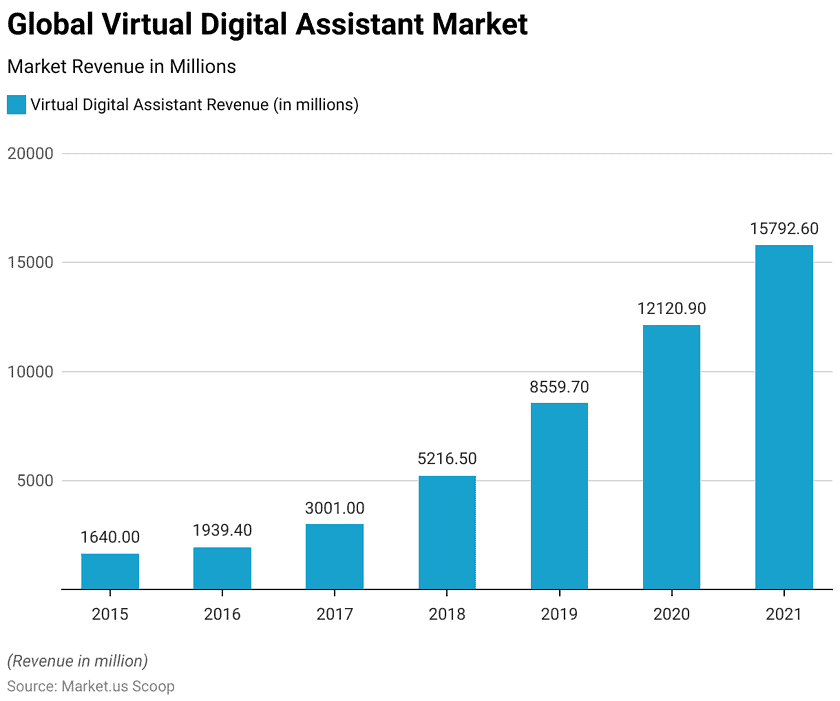
Industries Utilizing Virtual Assistants Statistics
- Virtual assistants have gained significant traction across diverse sectors, with varying degrees of utilization. They play a central role in administrative work, being adopted by 37.7 percent of businesses.
- Their application extends to marketing, where they contribute to streamlined operations for 20.5 percent of entities.
- In sales and prospecting activities, these digital aids are employed by 14 percent, facilitating more efficient processes.
- Within the sphere of operations, a notable 9.7 percent of businesses rely on virtual assistants to enhance their workflows.
- In customer service, these tools have found a place in 6.3 percent of enterprises, bolstering interactions with clientele.
- Additionally, they assist in finance and bookkeeping tasks for 4.3 percent of businesses.
- Across a range of other sectors, virtual assistants are harnessed by 7.5 percent of organizations, showcasing their versatility and applicability in addressing diverse operational needs.
(Source: Virtudesk)
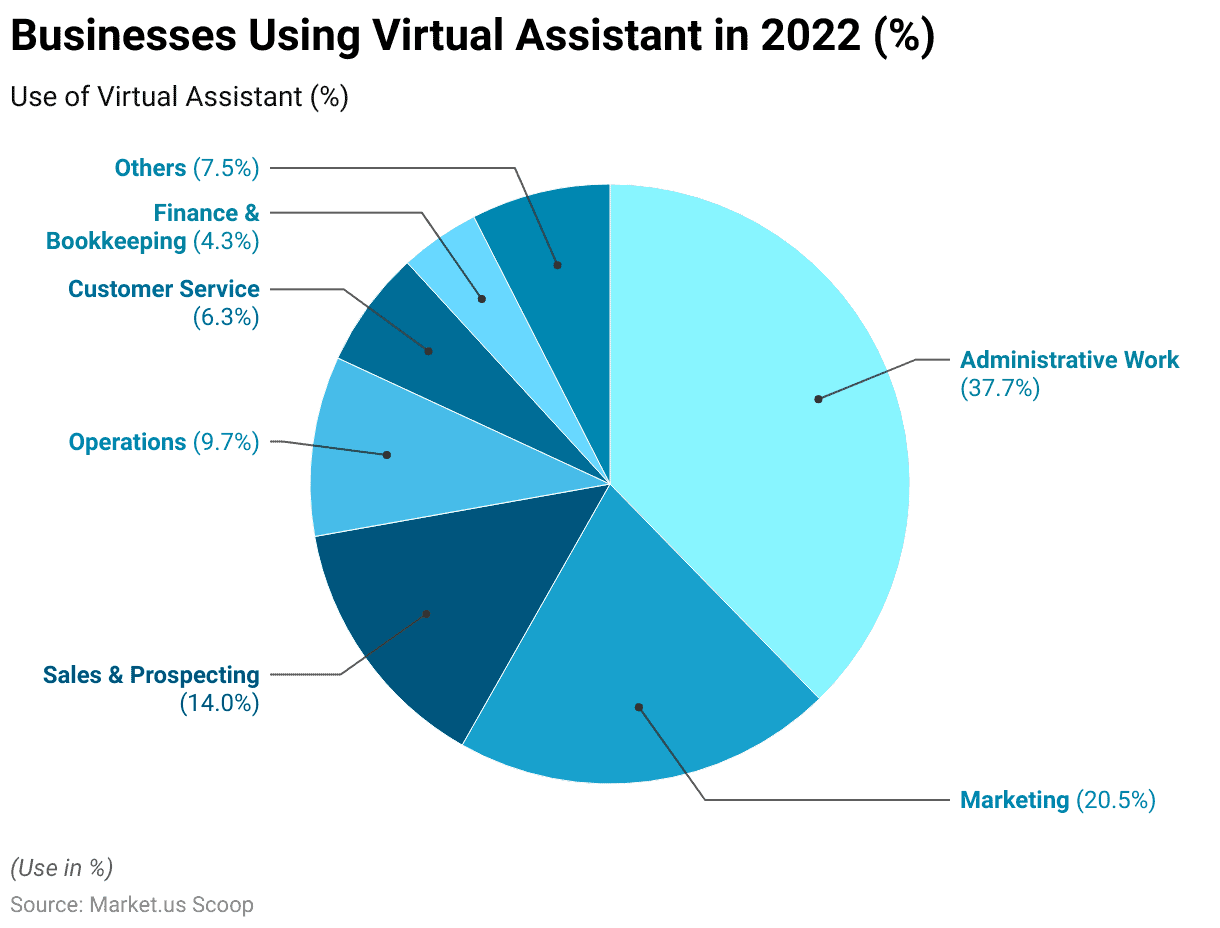
Consumer Adoption and Preferences
- In a survey conducted by PwC involving 1,000 individuals aged between 18 and 64 in the United States, 10% of respondents were unfamiliar with voice-enabled devices and products.
- Among the remaining 90% who were acquainted with such technology, the predominant segment (72%) had engaged with a voice assistant.
- The impetus behind this adoption is attributed to younger consumers, households with children, and those with an annual income exceeding $100,000.
- Despite the ubiquitous accessibility of voice assistants, 74% of consumers use their mobile voice assistants primarily within their homes. Feedback from the majority of participants in focus groups emphasized a privacy preference when interacting with their voice assistants and expressed reservations about using them in public due to perceived social awkwardness.
- This inclination could elucidate the lower usage of voice assistants among individuals aged 18 to 24, given their propensity to spend more time outside their residences.
- Half of the survey respondents, or 50%, have utilized their voice assistants to make purchases, and an additional 25% are open to doing so in upcoming instances. The items typically bought through this channel are often small and practical, which don’t necessarily require a physical assessment to gauge quality. A satisfactory shopping experience can foster increased loyalty, trust, and expenditure. On average, a notable 80% of consumers who have engaged in voice-assisted shopping express contentment.
Leading to the Following Outcomes:
- 39% have shared their favorable experiences with friends and family.
- 39% have repeated purchases with the same retailer.
- 36% have developed a more positive perspective of the retailer.
- 24% have increased their expenditure with the retailer.
- Nonetheless, a prevailing sense of distrust remains prevalent. A significant proportion, one in four consumers, would abstain from utilizing their voice assistant for shopping, either presently or in the future:
- 46% expressed hesitance due to doubts regarding their voice assistant’s ability to interpret and process orders accurately.
- 45% cited discomfort or lack of trust in transmitting payments through their voice assistant.
(Source: PwC Consumer Intelligence Series Voice Assistants Survey 2018)
Take advantage of our unbeatable offer - buy now!

Adoption of Virtual Assistant in Home Statistics
- Virtual assistants have established a significant presence in home equipment, as survey responses indicate their adoption across various categories. Notably, 58% of respondents reported utilizing virtual assistants with televisions, showcasing their integration into entertainment systems.
- Lighting control follows closely, with 36% of participants employing virtual assistants to manage lights, highlighting their role in enhancing home ambiance.
- Regarding environmental control, 29% of respondents utilize virtual assistants for regulating thermostats, contributing to energy efficiency.
- Additionally, 26% have integrated virtual assistants into alarm systems for enhanced security measures.
- The utilization extends to outlets and switches (22%), underscoring their role in home automation.
- Even small smart appliances witness virtual assistant usage at 19%, streamlining daily tasks.
- Virtual assistants also find a place in ensuring home security, with 18% using them to manage locks and garage doors.
- Lastly, 16% have integrated virtual assistants into doorbell systems, exemplifying their diverse applications across various facets of home equipment.
(Source: PwC Consumer Intelligence Series Voice Assistants Survey 2018)
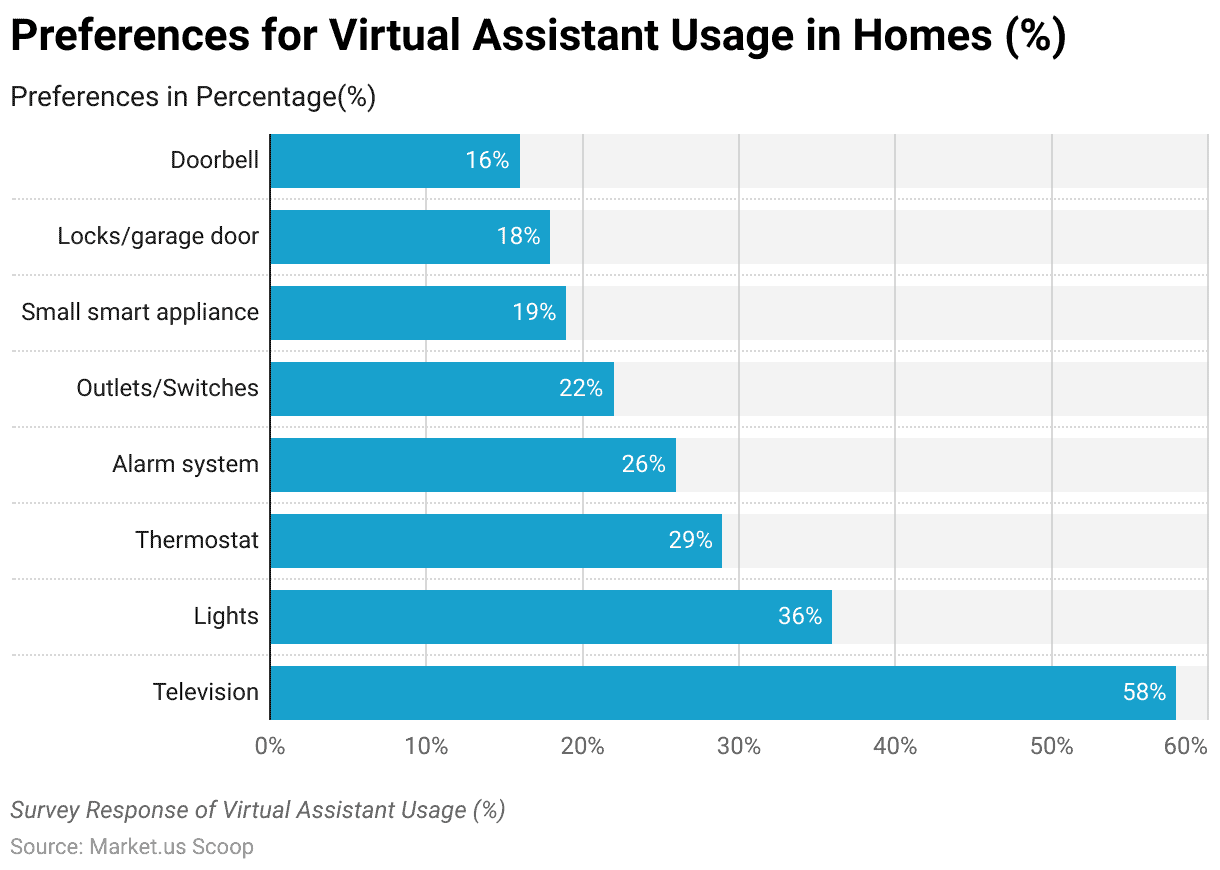
Virtual Assistance Statistics by Gender
- Utilizing virtual assistants demonstrates a balanced gender distribution, as survey responses indicate. Among the respondents, 51% identify as female, while the remaining 49% identify as male.
- This parity in virtual assistant usage across genders underscores their widespread adoption and integration into daily routines, transcending gender boundaries.
(Source: Survey for Characteristics and usage patterns of Smart Voice Assistants for shopping purposes among Jordanian consumers)
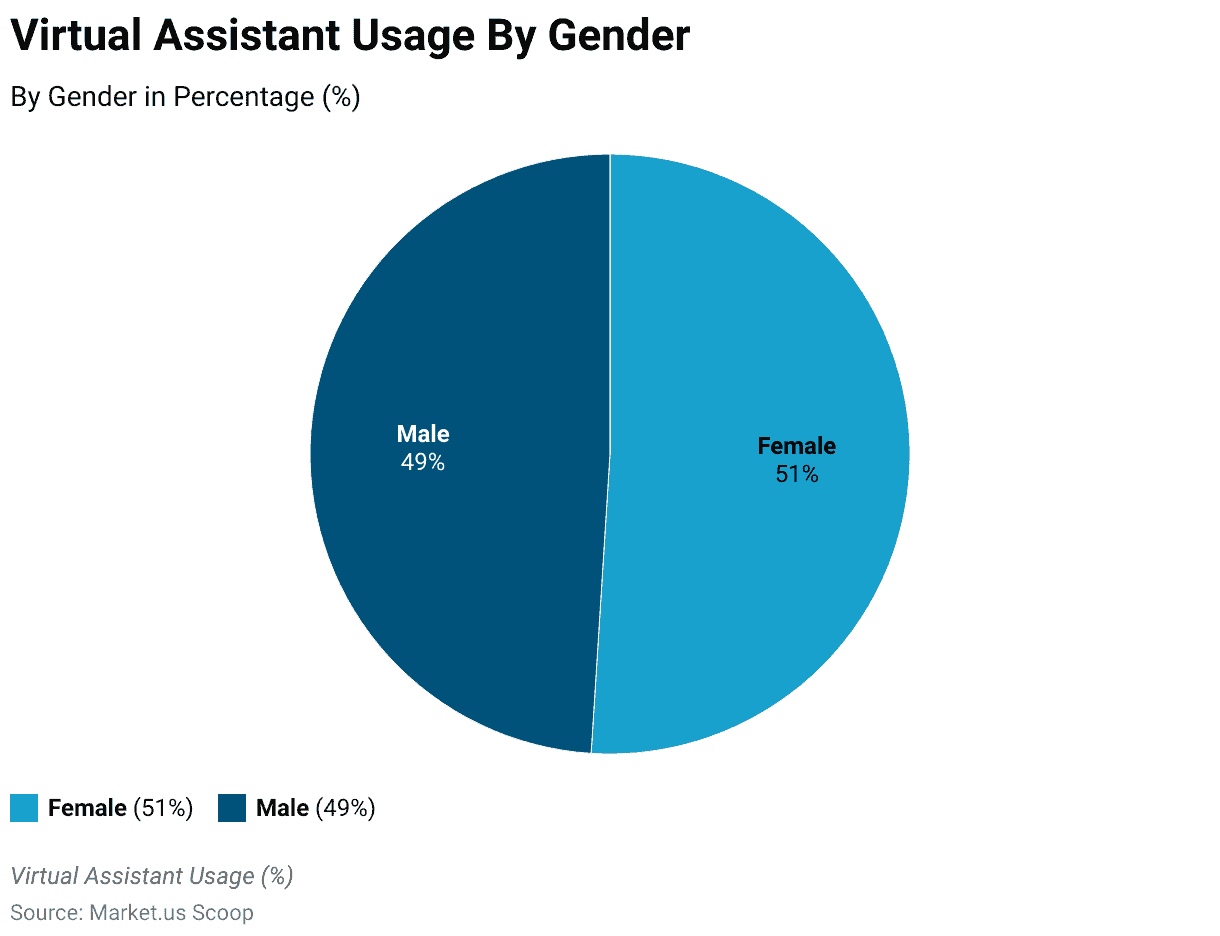
Virtual Assistance Statistics by Age
- Virtual assistant usage spans various age groups, revealing distinct patterns of adoption. Among individuals aged 18 to 29, 28% actively employ virtual assistants, showcasing their prevalence among younger demographics.
- Similarly, in the 30 to 39-year bracket, 32% of respondents engage with virtual assistants, indicating a continued usage trend.
- Meanwhile, the 40 to 49-year age group and those aged 50 and above exhibit equal usage levels at 20%, suggesting a consistent appeal that transcends generational divides. This data illustrates that virtual assistant utilization has permeated various age cohorts, underscoring its relevance and adaptability across different stages of life.
(Source: Survey for Characteristics and usage patterns of Smart Voice Assistants for shopping purposes among Jordanian consumers)
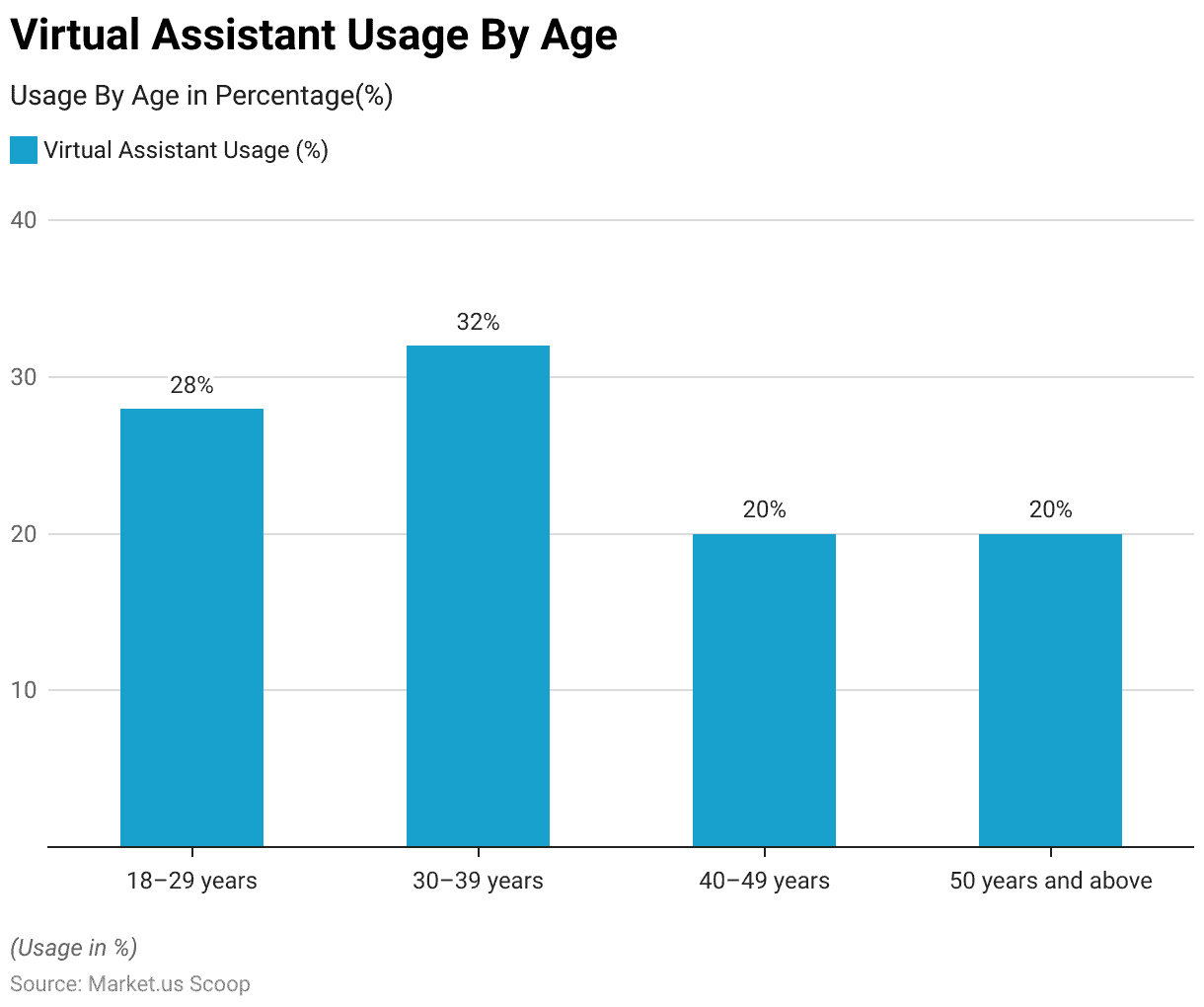
Virtual Assistance Statistics by Academic Qualification
- Virtual assistant usage correlates with varying academic qualifications, reflecting nuanced preferences across educational backgrounds. Respondents with a high school diploma represent 17% of virtual assistant users, showcasing their engagement among individuals with foundational education.
- Of those holding a bachelor’s degree, 29% actively utilize virtual assistants, indicating a higher propensity for adoption among this cohort.
- Virtual assistant usage remains prominent even among individuals with higher academic attainments; 23% of those with master’s degrees engage with these tools, while 12% of respondents possessing a Ph.D. or higher qualifications also partake in their usage.
- This distribution underscores the diversified appeal of virtual assistants across individuals with differing educational accomplishments, highlighting their adaptability in catering to a wide spectrum of users.
(Source: Survey for Characteristics and usage patterns of Smart Voice Assistants for shopping purposes among Jordanian consumers)
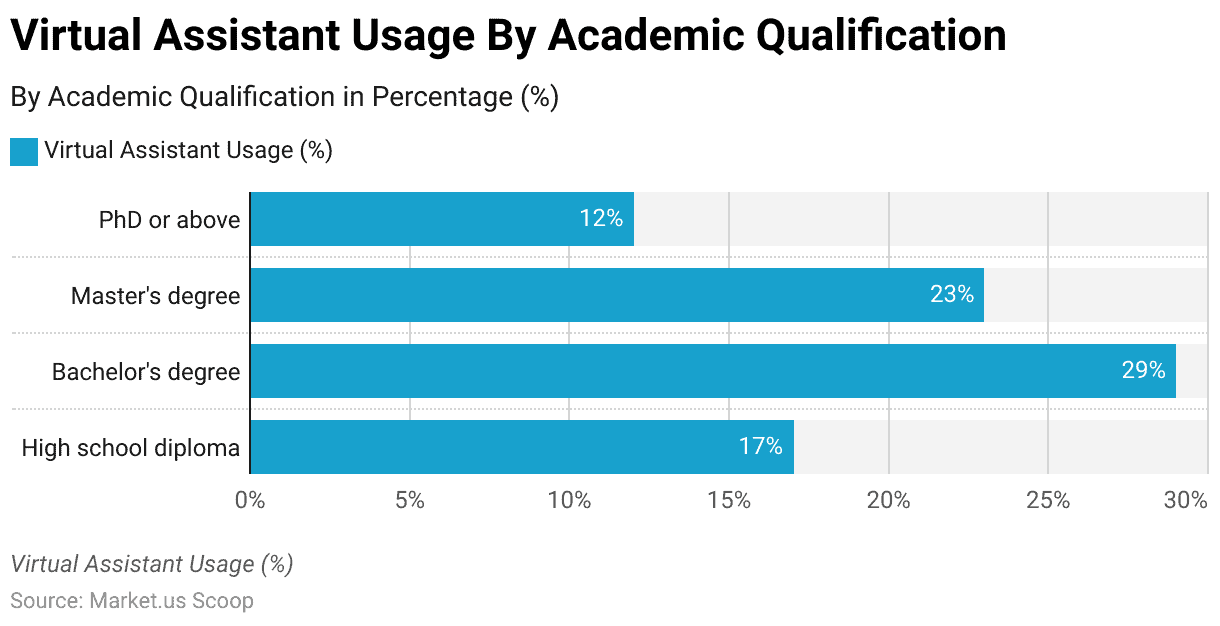
Virtual Assistant Statistics by Major Key Players
Amazon Alexa
- As of the most recent data, around 68.2% of smart speaker users within the United States opt for Amazon Echo, an Amazon device powered by the virtual assistant Alexa. This percentage indicates a slight reduction of 1.5% from the figures recorded in 2020.
- Amazon Alexa achieved the top position in the global smart speaker market in 2019, commanding a share exceeding 21.7% of the total global smart speaker market.
- In a testament to its expanding ecosystem, Amazon Alexa facilitated compatibility with over 100,000 smart home devices, marking an impressive growth of about 40% compared to the 60,000 supported devices in 2019.
- Amazon Alexa’s appeal is expanding across various age brackets due to its versatile features and applications. Amazon Echo’s data highlights a divergence in Alexa usage among different age groups. Among the younger demographic aged 18 to 24, only 19% regularly engage with Alexa.
- However, a comparatively higher proportion of those aged 25 to 34, amounting to 29%, actively utilize the platform.
- In contrast, Alexa finds stronger traction among middle-aged and older individuals. The age group spanning 35 to 44 years constitutes 39% of users, while the segment of 45 to 54-year-olds comprises 34%.
- More than 40% of users fall into the 55 years and above category. These patterns illustrate that Amazon Alexa’s adoption rates are notably prominent among middle-aged and older generations, suggesting its effectiveness in catering to a diverse range of age-related preferences and needs.
(Source: Earthweb)
Apple Siri
- Apple asserts that Siri is being utilized by 500 million individuals globally; however, the frequency of usage, whether daily or monthly, remains undefined.
- Apple also states that 98% of smartphone users have experimented with Siri, yet not all consistently incorporate it into their routines.
- This discrepancy may arise because Siri was integrated into models after the iPhone 4S, resulting in many users trying it out only a few times.
- As of March 2017, among adults in the United States, 9 percent of respondents utilized Apple Siri on multiple occasions throughout the day.
- A combined 65 percent of those surveyed did not use the virtual assistant.
- In a survey carried out in January 2019 in the United States, participants were asked about their contentment with the overall functional capabilities of Apple’s Siri.
- According to the results, 47 percent of the respondents expressed high satisfaction with Siri’s functions.
- Siri integrated into the HomePod exhibited an impressive 99.4% accuracy in comprehending inquiries, largely attributed to its noise cancellation capabilities.
- Analysis by Loup Ventures indicates a substantial enhancement in Siri’s performance from 2017 to 2018, as its precision started at a mere 52.3%.
(Source: Voiceseo, Statista, Voiceseo, 2018 Loop Ventures Survey)
Google Assistant
- According to virtual assistant statistics, at present Google Assistant holds the forefront position with a market share of 46%.
- It is projected to substantially widen this lead by the year 2022, surpassing the 60% mark.
- The total count of Google Assistant apps steadily rose over several months. In April 2017, the count was 165, then increased to 232 in May.
- Subsequently, it climbed to 304 in June, followed by 378 in July and 468 in August.
- The upward trend continued, with a notable surge to 724 by October 2017.
- The most significant leap occurred by January 2018, reaching a total count of 1,719 Google Assistant apps.
- In 2022, the landscape of voice assistants was already bustling with activity as millions of users engaged with these innovative technologies. Google Assistant boasted a user base of 81.5 million, while Siri, Apple’s renowned voice assistant, commanded a substantial user count of 77.6 million. Not far behind, Alexa, the voice assistant developed by Amazon, was embraced by 71.6 million users.
- Fast forward to 2024, and the growth trajectory of these voice assistants remains evident. Google Assistant’s user base swelled to 88.8 million, showcasing a continued preference for its capabilities.
- Siri also experienced growth, reaching 84.2 million users who found value in its features.
- Although slightly more modest in its expansion, Alexa still managed to captivate 75.6 million users. These escalating user figures vividly illustrate the widespread integration of voice assistants into the daily lives of millions, reaffirming their significance in shaping the way we interact with technology and information.
(Source: Voicebot.ai)
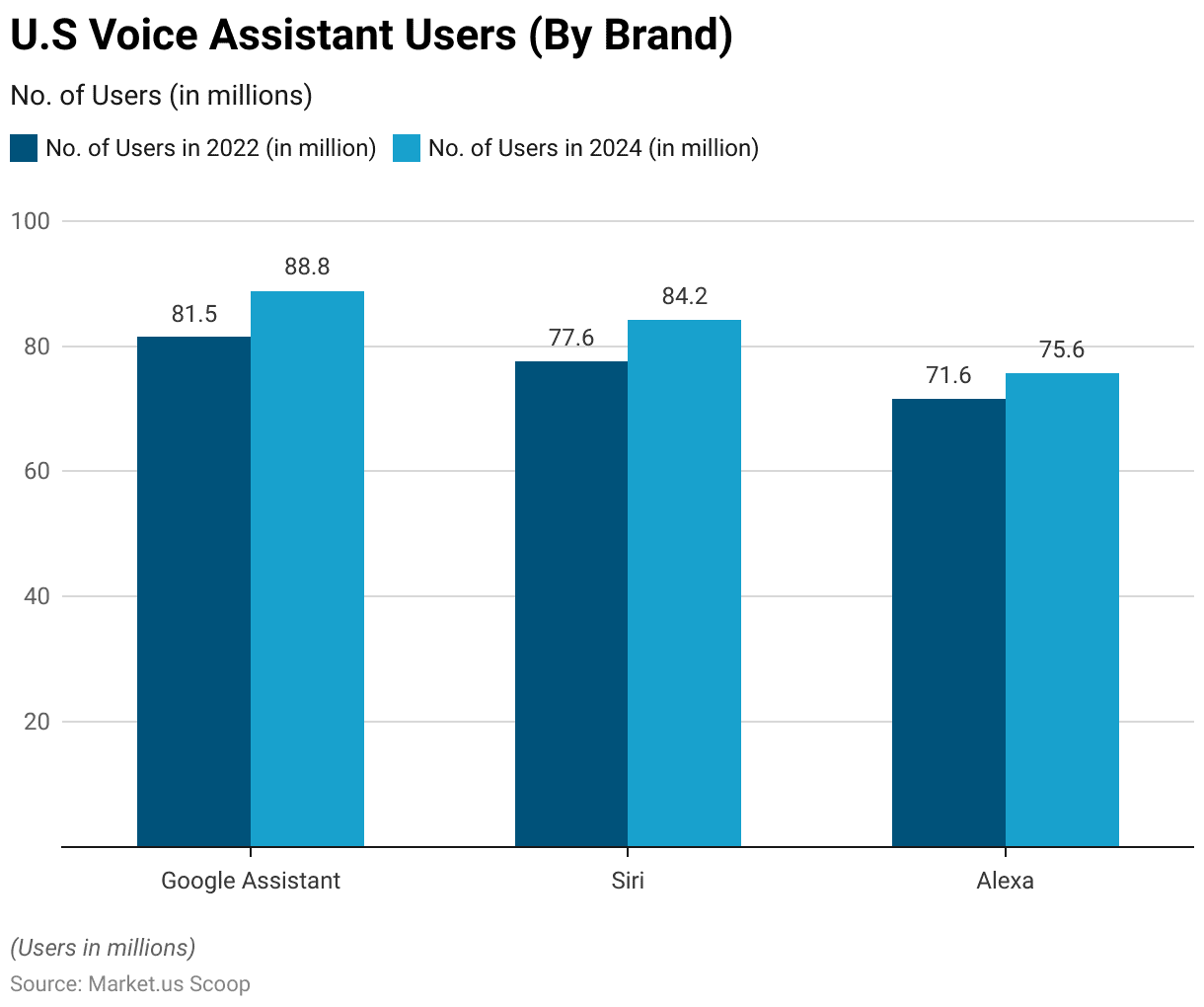
Virtual Assistant Statistics by Employment
- The year 2020 saw a notable 41% surge in the recruitment of virtual assistants through offshore agencies.
- Among these virtual assistants, 59% held full-time employment positions. While the traditional 9 to 5 office workday remains prevalent in numerous companies, many businesses embrace remote work policies.
- Statistical data concerning virtual assistants underscores that 85% of remote workers reported heightened productivity while working from their homes.
- The Philippines stands out as the favored destination for hiring virtual assistants, primarily due to its cost-effective average monthly rate of $400.
- Most Americans perceive it as budget-friendly. On the contrary, the virtual assistant industry statistics indicate that professionals.
- The United States engaged in this field earn as much as $4,000 per month.
- Trends in virtual assistants reveal that some workers actively advocate for this practice out of concern for falling behind on their tasks. Another 20% doubt is finding capable individuals to complete their assigned tasks, while 13% remain open to exploring new opportunities.
- An impactful aspect of virtual assistants is their potential to slash operating expenses by an impressive 78%. Diving into demographics, it’s noteworthy that 75% of virtual assistants in the US are above the age of forty. Regarding gender distribution, the virtual assistant market is predominantly occupied by women, constituting 83% of the virtual assistant population in the United States.
- According to virtual assistant statistics, one out of every eight million virtual assistants on Upwork hails from the Philippines. Companies from various nations prefer Filipino virtual assistants due to their easy collaboration and a high literacy rate of 96.2%. Furthermore, they hold the distinction of being the most economical virtual assistants globally.
(Source: NanoGlobals, Virtudesk, Best of Budgets, CBS News, Best of Budgets, Zippia, Virtudesk)
Recent Developments
Acquisitions:
- Google’s Acquisition of HTC’s Smartphone Division: Google acquired HTC’s smartphone division for $1.1 billion, enhancing its hardware capabilities and supporting the development of its virtual assistant technologies. This acquisition allows Google to integrate hardware and software seamlessly, improving the performance and reach of Google Assistant.
New Product Launches:
- Microsoft’s Windows Copilot: In May 2023, Microsoft announced Windows Copilot, an AI assistant integrated into Windows 11. This assistant provides users with enhanced productivity tools directly from the taskbar, allowing for easier navigation and task management across various applications.
- Inflection AI’s Pi Chatbot: Inflection AI launched the Pi Chatbot, designed to be a friendly and helpful personal assistant. This new chatbot uses advanced AI trained on extensive internet text to provide diverse and accurate responses to user queries.
Funding:
- Significant Investment in AI Startups: AI startups focusing on virtual assistant technologies continue to attract significant funding.
- In 2023, various companies received substantial investments to develop and enhance their AI capabilities, driving innovation in the virtual assistant market.
Market Growth:
- Expansion of the Intelligent Virtual Assistant Market: The growth is driven by increased adoption in consumer electronics, healthcare, BFSI, and retail sectors.
- Rapid Growth in the Asia-Pacific Region: The Asia-Pacific market for intelligent personal assistants is expected to grow significantly due to the rising adoption of advanced technologies and the expansion of the retail and consumer electronics sectors.
Innovation in AI Technologies:
- Advancements in Natural Language Processing (NLP): Companies like Google are heavily investing in NLP and deep learning to improve their virtual assistant capabilities.
- These advancements are aimed at enhancing the accuracy and responsiveness of virtual assistants, making them more useful and reliable for users.
Strategic Partnerships and Collaborations:
- IBM and TD Securities Collaboration: In February 2022, IBM collaborated with TD Securities to create an AI-powered virtual assistant using IBM Watson.
- This assistant helps consumers with inquiries about the TD Precious Metals digital shop, streamlining the purchasing experience and improving customer service.
Conclusion
Virtual Assistant Statistics – Voice assistants have rapidly transformed from novel innovations to integral parts of our daily lives.
The Virtual Assistant Statistics presented in this report highlight the remarkable adoption, diverse applications, and evolving capabilities of voice assistants across various sectors.
These digital companions have revolutionized how we interact with technology and paved the way for new possibilities in accessibility, convenience, and connectivity.
The data showcases the widespread adoption of voice assistants, with millions of users relying on them for tasks ranging from basic queries to complex interactions.
Market leaders have emerged, each striving to enhance their platforms’ capabilities and gain a competitive edge.
FAQs
A voice assistant is a software-based artificial intelligence (AI) tool that uses natural language processing (NLP) to understand and respond to spoken commands. It can perform tasks, answer questions, and interact with users through voice interactions.
Leading voice assistant platforms include Amazon Alexa, Apple Siri, Google Assistant, and Microsoft Cortana. Amazon Alexa and Google Assistant have particularly large user bases.
Voice assistants are used for various tasks, including setting reminders, playing music, checking weather forecasts, sending messages, making calls, and controlling smart home devices. They are also increasingly being integrated into healthcare, automotive, and e-commerce industries.
The future of voice assistants involves more natural and context-aware conversations, improved emotional intelligence, and integration into emerging technologies like augmented reality and autonomous vehicles.
Studies have shown that voice assistants can influence consumer choices and preferences. Users often appreciate the convenience of hands-free interactions and the personalized experiences that voice assistants can provide.
Discuss your needs with our analyst
Please share your requirements with more details so our analyst can check if they can solve your problem(s)



